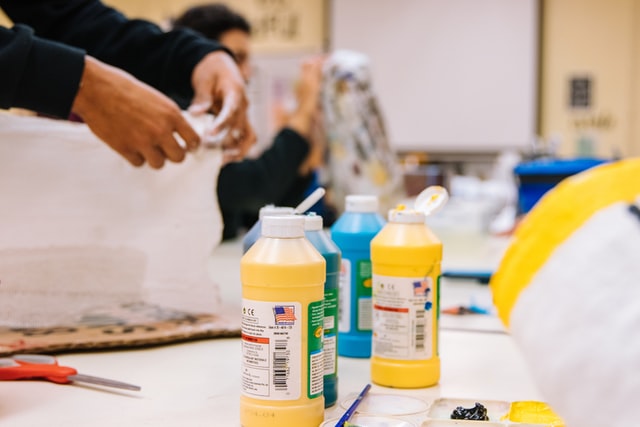Knowledge is better retained when the brain is happy and relaxed, which is why it is essential to remember to have fun while homeschooling! School and fun aren’t typically used in the same sentence by students; however, remote learning allows for a bit more flexibility in this area. Incorporating fun games and projects into your child’s lessons are the perfect way to keep them interested in learning as well as provide a change in scenery from what they typically experience in a traditional school setting. Here are some of the top ways you can make homeschooling exciting for your child!

1.) Game Time
Games are a great way to show students that learning doesn’t have to be boring. Educational games will teach your child to love school and even look forward to it! Games can be set up to teach or practice a variety of skills such as math, critical thinking, problem-solving, verbal communication, and so much more! Many parents don’t know just how educational certain games can be and just how much knowledge a child can retain from a game like scrabble. This is the perfect way to get children excited about learning and help them absorb information quicker since their brain is not under so much stress.

2.) Movies & Documentaries
Watching a film about a particular subject or lesson is the perfect way to gain some new knowledge. Plus, visual learners will benefit greatly from this method. Gather your children together in the living room, pop some popcorn, and put on an educational film of your choosing. This will be a nice break from traditional learning, plus your child’s brain will still be active. There are many resources available online with educational videos and clips that you and your child can use throughout the school year. YouTube is a great source as well!

3.) Field Trips
Head on over to a museum or to the planetarium if you can. Many museums offer virtual tours as well if you are unable to get out to one. Children can learn something just about anywhere, even in the park. Allowing students to experience a new learning environment beyond what they are used to will excite them and kick-start their brains. Being cooped up in the house all day can make anyone go crazy! Surprise your child by planning a field trip that will be both fun and educational. After a field trip, ask your child what they learned and perhaps even have them draw or paint a picture to describe it or do another fun activity such as a quiz game to test their knowledge. This way, children can cement new information into their brains without the stress of a traditional study session.

4.) Outdoor Adventures
There are so many ways to have fun outdoors. Switch up your learning environment and watch your child thrive. Here are some fun activities you can try with your child:
- A nature hike
- Scavenger hunt
- Fishing
- Camping
- Kayaking
- Swimming
Whatever you decide to do, make use of the outdoors. You won’t regret it! Fresh air and sunlight are often just what the brain needs to refresh itself and get ready to dive back into learning.

5.) Cooking
Create your own version of home economics by finding fun but simple recipes for you and your children to cook together. You can also ask which ones they might like to try. Cooking is a great way to not only activate the creative part of the brain but to learn new skills and bond with your family as well. You could even host a cooking show and compete to see who can make the tastiest or most creative dish! Who will come out on top? Pretend like your family is on Master Chef and cook up a storm!

6.) Art
Art is an excellent way for students to destress and practice their sketching and shading skills. Make your own in-home art class setup and block off some time in the day to do a fun project. Challenge the creativity of your child by giving them a topic to go off of or even just allowing them to draw freely. They can utilize paint, charcoal, pipe cleaners, buttons, or anything that comes to mind. Art is a great activity to have fun with because it is not restrictive, anything can be art, and anyone can be an artist. Challenge your child to bring out their inner Picasso in your homeschooling sessions.

7.) Learn A New Language!
This will give your child the opportunity to not only have a cool new skill to share with friends and family, but also to immerse themselves in other cultures. Learning a different language is very interesting and it is exciting to watch yourself pass new milestones as you pick up new words and phrases. Give it a try! Even just 30 minutes each day is the perfect way to spice up your learning routine. From Chinese, Spanish, German, French, and so many more, the options are plentiful. Plus, you never know when being bilingual or multilingual will come in handy in life.

8.) Prize System
Children love being rewarded! They will be so grateful if they receive special privileges or gifts for doing a great job in their studies. You might try filling a basket with different things such as candy or small toys for younger students. If you have teenage children perhaps you can take them to get their favorite food, to buy a new pair of shoes, or let them stay up a bit later than usual. Rewards are also an extreme motivator since children will want to continue doing well in school so they are able to receive more prizes.

9.) What Is Your Child’s Learning Style?
All children have different ways in which they learn best. Use this to your advantage. There is no need to feel like you have to conform to any specific teaching method while homeschooling. Students will enjoy learning so much more when it fits their specific style. Try to adjust lesson plans as needed to make the learning process a more seamless one. If your child is a kinesthetic learner, meaning they learn best by being hands-on, try giving them projects that involve building things or putting on a performance to help them remember.
If your child is an auditory learner you can download audiobooks for them, play videos without the graphics, or read chapters with them out loud since that will allow the information to stick. Visual learners are the opposite in this aspect since they would benefit more from the graphics of a movie than the audio. They would also benefit from concept maps, flow charts, and the like. No matter your child’s learning style, try to make school fun by adjusting the lessons for them when applicable in order to increase long-term retention. This will also make them eager to start class each day!

10.) Grow A Garden!
This is the perfect project for Science class. Let your child pick out different flower seeds or vegetable seeds and get all of your garden supplies together. Plant and label your seeds and watch them sprout into beautiful sunflowers, roses, tomatoes, or fresh herbs for cooking. Gardening is a great opportunity for your child to witness photosynthesis in action while also getting to reap its benefits. Plus, you’ll always have fresh herbs and vegetables to use during cooking class and beautiful flowers to place around the house if you wish to.
So, you want to make homeschooling exciting? Try some (or all) of these fun activities with your child! School is often described as boring, but it doesn’t have to be. Try switching your perspective and creating excitement where there usually isn’t very much of it. Turn school into a rewarding adventure that will inspire your young student down their educational path, and you’ll get to have some meaningful bonding experiences along the way.























